'Who's Next': The rise of Felicity Taylor and girls' wrestling in Iowa
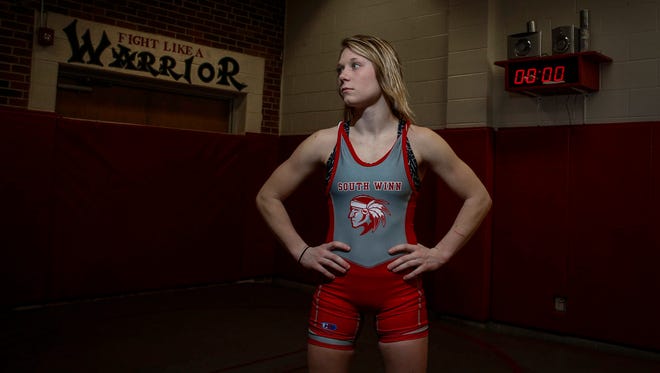
CALMAR, Ia. — The South Winneshiek wrestling room is tucked behind wooden doors between the main gym and the locker rooms. It’s about the same size as a regulation wrestling mat. It's hot in there, but Felicity Taylor is wearing tights and a sweatshirt. She needs to shed a few pounds.
“Makes it easier by the end of the week,” she says.
It’s Jan. 31. The next weekend, Taylor will take second at 106 pounds in a Class 1A sectional to keep her season alive. The junior failed to reach this week's state wrestling tournament at Wells Fargo Arena, but her impact may soon take on a greater significance.
STATE TOURNEY MOBILE BRACKETS | STATE TOURNEY DESKTOP BRACKETS
Taylor’s success — she went 34-11 this season — represents another step forward in the rise of females competing in the male-dominated sport of wrestling. During the 2005-06 school year, 4,975 girls wrestled nationwide, according to the National Federation of State High School Associations. Last year, that number had grown to 13,496.
Back at South Winneshiek, the wrestlers warm up and begin drilling. Taylor works on her neutral offense, walking through the technical aspects of each shot in the hopes of creating muscle memory — so when she hits them in live competition, she can just act and not think. In the few years she’s wrestled, she’s learned, like all wrestlers do, that good technique most often wins.

Soon, coach Jacob Elsbernd blows his whistle. It’s time to wrestle. Taylor pairs up with Gabe Sadler and Logan Schnuelle, South Winneshiek’s 113- and 126-pounders. Over the next hour, both boys take turns beating Taylor in situational drills, their size being the primary advantage. She gets back up each time, never frustrated, always focused.
Every few minutes, Taylor catches a breather and reties her hair. Once finished, she pops her head up and looks at the wall.
Six years ago, when Elsbernd returned to coach at South Winneshiek, the walls were bare. He covered them with accomplishments to connect the program to its past and inspire its future. On the south wall, banners list conference champs, state qualifiers and those who won 100 career matches. On the north, flags hang for Warriors who wrestled in college.
On this day, Taylor shoots a glance at the east wall, where 21 posters recognize the program’s state-placewinners. They list the wrestler’s name, weight, placement, year, win-loss record and show a picture of the wrestler on the winner's podium.
All 20 of them are boys.
The 21st poster reads: “Who’s Next?”

MORE:
Why many Iowans won't be able to watch state wrestling on TV
BRACKETS: 2017 Iowa high school state tournament brackets
PHOTOS: Iowa high school wrestling through the years
PHOTOS: Four-time wrestling state champions
Could Iowa sanction girls' high school wrestling?
Mason City’s Cullan Schriever ready for his first crack at state title
State tourney fans: What's new in Des Moines since last year
Matt Watters sat in his office at the Midwest Heritage Bank on a Monday night in West Des Moines, typing away on a spreadsheet. He writes for IAWrestle, a website that covers all levels of wrestling in the state of Iowa. Specifically, he covers girls’ wrestling.
On the spreadsheet, Watters lists every girl that wrestles at the high school level in Iowa, along with their record. He tracks down results — wins, losses, even forfeits, for both varsity and junior varsity — for his weekly post. The spreadsheet has grown over the last few seasons.
Four years ago, only 37 girls wrestled in Iowa, according to Trackwrestling, a website that helps track wrestling seasons and organize tournaments. This season there were 92 girls, including a handful in the Des Moines area. Next year, Watters expects at least 100 in total.
“These girls are working so hard,” Watters said. “... These girls really just want to wrestle, and this is their only opportunity to do so.”
The growth nationally — punctuated by Helen Maroulis’ gold-medal performance at last summer’s Olympic games in Rio de Janeiro, the first for any U.S. woman wrestler — is due in large part to the sanctioning of girls’ wrestling in other states. That's allowed girls to wrestle other girls and not boys. It's likely a few years from becoming a reality in Iowa.
Now, six states host girls’ state wrestling championships — Alaska, California, Hawaii, Tennessee, Texas and Washington — while another 39 states (Iowa included) allow girls to wrestle on boys’ teams. Terry Steiner, the national women’s freestyle head coach, said as many as nine other states are considering having girls' wrestling sanctioned within the next year or two.
“For the last three years, women’s wrestling has been the fastest growing sport at the high school level,” added Steiner, a three-time NCAA All-American who won a national championship in 1993 for the University of Iowa, “and we’ve had continued growth in women’s wrestling for 27 straight years.
“If they’re really looking at which sports are adding numbers, we definitely are one of those sports that should be considered.”
Watters, like many others, views Taylor as the current face of the girls’ wrestling movement in Iowa, a role she's fully embraced.
“She’s opened my eyes to a lot by doing what she’s doing," Elsbernd said. "If she can do it, why can’t other girls?”
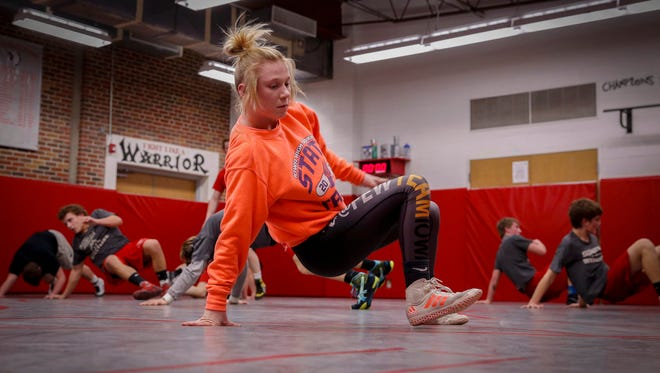
Taylor’s story begins with gymnastics. She started at 4 years old and was a Level 8 gymnast by middle school — for reference, collegiate and Olympic gymnasts are Level 10. But the time commitment became too much, so in eighth grade, she tried out for wrestling cheerleading.
“That was my main goal,” she said, “and I actually cried when I found out I didn’t make the team because that was the one thing I wanted to do.”
Left without a winter sport commitment — Taylor is also a successful cross country and track athlete — she tried both basketball and basketball cheerleading, but didn’t enjoy either. One day, she approached Elsbernd and inquired about joining the wrestling team. He told Taylor to talk to her parents and he’d talk to the team, then they’d convene later that week and decide.
Christa Taylor didn’t see an issue. She knew her daughter possessed the necessary strength and saw that she thrived in solo competitions.
“There were some people in the beginning who were like, ‘Oh come on. Let that just be the guys. That’s not a girl thing,’” Christa Taylor said. “So that was a little bit of a transition, getting everybody on board with it.
“But she showed she could keep up with all of them, if not kick their ass.”

The 2014-15 season was already three weeks old by the time she started, so Felicity Taylor went to an open mat session one Sunday night to learn the basics. She worked with Ethan Adams, a former South Winneshiek wrestler turned assistant coach. She was hooked by the time she left.
“He worked with me on my penetration step,” Taylor said, “and I learned both sides within an hour. He said it’s taken some people two years to get that down. So I knew it was something I could do.”
In a few months, Taylor went from attempting front headlocks for six straight minutes to executing takedowns with proficiency. She has video of her first few matches and laughs whenever she watches. It's a reminder of how far she’s come in such a short time.
That first year, she was inserted into the varsity lineup at times, posting a 10-8 record. She lost her first five matches, including three by fall. But she won three of her last four matches that season.
“What really separates her from others in the room is her ability to learn,” Elsbernd said. “We’ll show her something on Monday night, and by a Tuesday or Thursday dual, she’s hitting that move.
“Off the mat, there were little things we had to get used to. During the school day, when she wants to check her weight, we make sure nobody is in the room when she goes in there. At the (Upper Iowa Conference) tournament, we had like 60 or 70 guys weigh in — then we kicked them all out and brought her in. Otherwise, it’s been an easy transition.”
After the season, Taylor searched for a club team to hone her skills for the next winter. She chose one of the handful in Decorah, about 20 minutes from her hometown, but left one practice in tears.
“She called me and said, ‘Mom, come get me,’” Christa Taylor remembers. “I had two parents call me and say, ‘You can’t let her go back there. They humiliated her in front of the whole class.’ Then Felicity told me, ‘If I have to go there, I’ll never wrestle again.’"
Taylor eventually found a home at Elite Takedown Club, an hour southwest in Waverly. There, she surrounded herself with some of the best wrestlers in northeast Iowa — like New Hampton's Michael Millage and Keaton Geerts, and Don Bosco's Gable Fox and Dan Kimball.
In addition to working with Elite’s coaches, Taylor watched the others practice and picked their brains about specific techniques and skills — Geerts and Kimball are ranked No. 1 at their respective weights while Millage and Fox are both ranked second in theirs. She improved dramatically.
That summer, July 2015, she competed against other girls at the Cadet women’s freestyle national tournament in North Dakota. She finished fifth in the country at 101 pounds, earning All-American honors.
“It was awesome,” Taylor said. “When I was a freshman, I knew some girls wrestled, but I didn’t know they wrestled in high school until I went to Fargo and realized how many girls are actually out wrestling.
“Now, this year, with so many girls out wrestling in Iowa, it’s just crazy. It’s grown so quickly.”
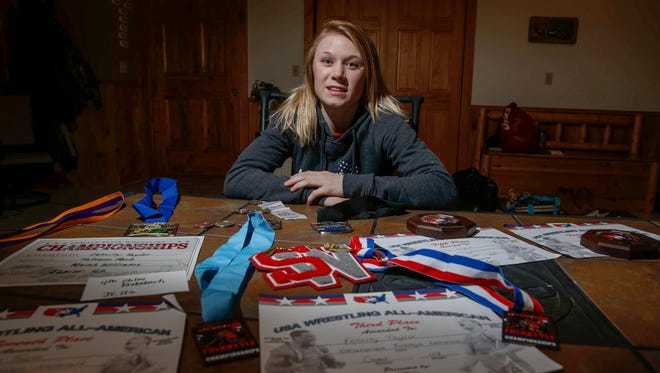
Challengespersist with girls wrestling. The number in Iowa is growing, but 92 is small by comparison — 20 other states, for example, had at least 100 girl wrestlers last year, led by California (4,104), according to the NFHS.
“If we’re really trying to grow the numbers, you can’t ask a girl to come onto a boys’ team," Steiner said. "Administrators won’t push that. Coaches won’t push that. Parents have doubts about it.
“The only way to truly grow it is to separate it.”
The conversation of sanctioning girls’ wrestling in Iowa is in its infant stages, said Jean Berger, of the Iowa Girls High School Athletic Union. She recently met with Alan Beste of the Iowa High School Athletic Association along with a collection of wrestling coaches, referees and supporters about pushing the conversation forward.
In order to add a new sport in Iowa, the association’s bylaws state that 15 percent of the active members must play that sport. Only then will the association’s Board of Control determine whether a “tournament series will be sponsored by the IHSAA in that sport,” according to the association’s handbook.
Berger says the girls’ union follows a similar protocol, but has some flexibility when it comes to creating new sports. She added that others are also being considered — rugby, lacrosse, triathlons and skeet shooting among them. She’s currently compiling the necessary participation data for all recommended sports, including girls’ wrestling.
“Women in Iowa are so knowledgeable about wrestling that I think they’re dying for an opportunity to wrestle,” says Wyatt Schultz, owner and publisher of The Predicament, a website that covers wrestling in Iowa.
“Realistically, it may not happen this year or next. You have teams to figure out, officials. Do you run it at the same time as the boys or do you run two separate tournaments? There’s a lot of details to work out before it gets rolling.”
Once the sport is sanctioned, participation has grown quickly elsewhere. Steiner points to Washington as an example. In 2006-07, the Washington Interscholastic Activities Association held its first girls’ state wrestling tournament of record. That season, according to the NFHS, 281 girls wrestled. Last season, that number ballooned to 1,184.
“The sport is so embedded into the state of Iowa that there’s girls out there that have fallen in love with the sport but have been told they can’t do it, for whatever reason,” Steiner said. “I’m sure that if you open it up and create an all-girls division, you’ll see the numbers pop.”
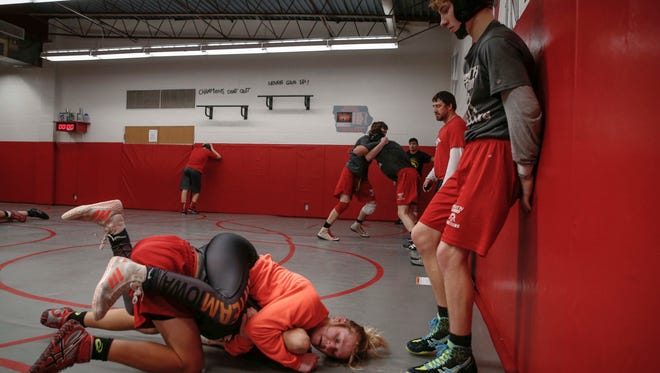
Felicity Taylor is aware of her role in the girls’ wrestling movement. She knows she probably won’t get the opportunity to compete against other girls during the winter season, so her focus is on wrestling boys — and beating them.
“A few of the younger kids I’ve seen her wrestle — highly-touted freshmen, but still young and emotional — and all of a sudden, a girl is beating you in front of all these people? That has taken some kids out of the match," Elsbernd said. "I’ll lean over to our assistants and go, ‘Yeah, she just broke that kid. There’s no way he’s winning this match.’”
Other girls have come before Taylor. In 2011, Cassy Herkelman of Cedar Falls and Megan Black of Ottumwa, both 112-pounders, became the first two girls to qualify for the Iowa high school state wrestling tournament. No other girl has qualified since.
Herkelman garnered national attention when she became the first girl to win a match at state, after Linn-Mar’s Joel Northrup defaulted from the bout because of religious reasons. The following year, Black became the first girl to win a state medal, placing eighth at 106 pounds in Class 1A for Eddyville-Blakesburg-Fremont.
Last season, Rachel Watters, a Ballard grad and Matt Watters’ oldest daughter, became the first female middleweight wrestler to win a sectional championship in Iowa. When Rachel started wrestling in elementary school, her dad signed her up for tournaments as “R Watters” so organizers wouldn’t know she was a girl. But after winning a 2016 sectional title at 145 pounds, Rachel said, “Hopefully, this will help more girls choose to come out for wrestling.”

Other girls came close to qualifying for state last weekend. Monticello's Alaina Sunlin qualified for Class 2A’s District 6 tournament at 106 pounds, but finished fourth, capping her season at 17-22. Another, Tateum Park of Davenport North, also took fourth at 113 pounds in Class 3A's District 6 meet. Park went 25-16 this year.
Taylor has already impacted the South Winneshiek community. She plans on hosting a camp soon to help teach young girls about wrestling — she said about 20 girls between second and eighth grade have signed up. Even more, the local youth program practices at the high school after the Warriors finish and, recently, a couple of girls have made appearances without Taylor saying a word. Elsbernd calls it the “Felicity Effect."
“The more girls that do it,” Taylor said, “the more other girls won’t be afraid to try it.”
Taylor is playing a key role in what's already a statewide movement at the youth level. On Feb. 26, a week after the high school state tournament, Wells Fargo Arena will host the first AAU girls' wrestling state championships for girls in kindergarten through eighth grade.
The rise of girls’ wrestling has reached the international level, too. In February 2013, wrestling was nearly axed from the Olympic Games. Wrestling legend Dan Gable, among others, spearheaded an international effort to save the sport. Seven months later, the International Olympic Committee voted to keep wrestling, a decision that came in part, Gable said, because of women's wrestling.
In October 2015, the Dan Gable Museum in Waterloo hosted the Gable Gala, where Steiner and Adeline Gray, a three-time world champion, were the guest speakers. Taylor met them both and got Gable’s signature shortly after he announced his support of girls’ wrestling at all levels (though he prefers girls-versus-girls).
“It's mostly a culture that needs to be changed, and it was a good start that night," Gable said recently. "It's not an easy sell in some places, but it looks like it's moving in that direction. I'm definitely for it.”
Ten months later, Maroulis set foot inside the Carioca Arena in Rio and became the United States’ first women’s wrestler to win Olympic gold (which is woman-versus-woman), an accomplishment that Steiner said legitimized that girls from the U.S. can reach the top of the sport.
A couple of weeks before, Felicity Taylor had already decided on her future goals. Before the opening ceremony, she pulled out her phone, opened Twitter and thumbed exactly 140 characters. She informed the world that she hoped “to be in the 2020 Olympics as a wrestler.”
As practice nears the end, Elsbernd instructs his wrestlers to run sprints. Down, back. Down, back. Down, back. Taylor runs with the fastest group. Then goes again with the middle group. Those few pounds won’t just fall off, of course.
Afterward, she returns home and admires her wrestling hardware. She keeps the awards tucked away in a drawer, only because she hasn’t installed a new shelf yet. When she does, it will be covered with miniature stop signs, certificates, wooden plaques and a slew of medals, all bronze, silver and gold.
She has more goals she hopes to achieve on her way to the 2020 Olympics. She wants to win a junior freestyle national championship. Wants to reach the state tournament. Wants to become the second girl to stand on the podium with a medal around her neck before her high school career is finished. Who’s Next?
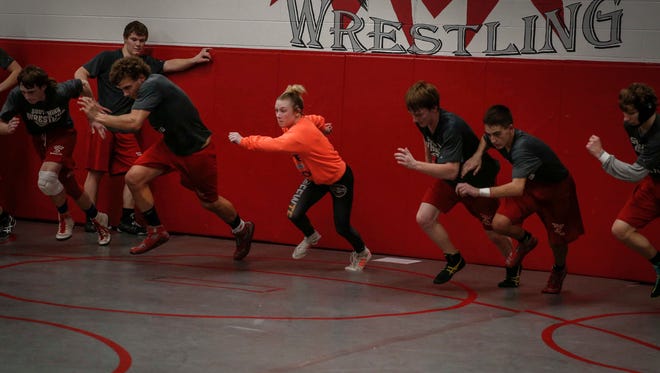
One award sticks out as her favorite, she says.
South Winneshiek, which went 20-3 this season, competed at the Decorah Viking Dual Tournament in mid-January. It was the same city where Taylor vowed she’d quit if she ever returned.
But that day, Taylor went 5-0 with two falls and was named the tournament’s “Most Outstanding Wrestler.”
It’s her favorite because the certificate doesn’t say “Girl Wrestler” — just, wrestler.
Cody Goodwin covers high school sports, college basketball recruiting and Drake athletics for the Des Moines Register. Reach him at (816) 582-0633, email him at cgoodwin2@dmreg.com, or send him a tweet at @codygoodwin.
